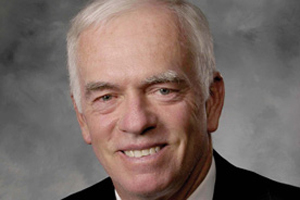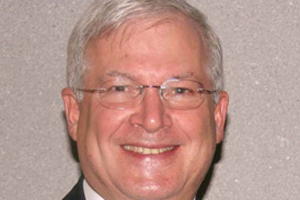A Bright Idea: How the Berry Center shapes tomorrow’s leaders
Jim McWethy ’65 wants you to know that the Berry Center has nothing to do with blueberries. Scratch that. Jim McWethy wants you to know that the Berry Center wasn’t named as such because of the tiny blue fruit. It was actually named for his grandfather, Lester Berry, who also had nothing to do with blueberries. But that’s jumping ahead.
These days, the Berry Center for Economics, Business, and Public Policy, as it is properly named, actually has quite a bit to do with blueberries. Not particularly by design, as it were, but by luck, circumstance, the timely eye and vision of McWethy himself, and a venture capitalist from Uruguay.
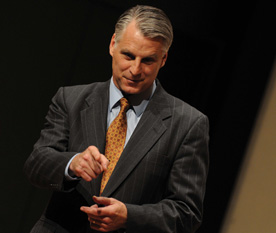
It was through that venture capitalist that seniors Audrey Saunders and Jeff Curran, alongside President Les and Katrina Garner, found themselves ducking the Iowa winter in a blueberry field in South America, questioning local farmers about the fruit business. And it was thanks to the Berry Center that they found themselves talking their way through the agrarian pastures of a coastal paradise.
While the center does such big things well, it’s better defined by the opportunities it affords students on an every day basis. The Berry Center is internships and interdisciplinary study, distinguished visitors and distinguished lectures, student research and job connections, off-campus learning and on-campus reading groups. The Berry Center is all of these things, and a sum greater than its parts.
Like all good ideas
“The idea really came from the president,” said A’amer Farooqi, faculty director of the Berry Center. “He came to us and asked, ‘If you had an initiative, what would you do, given the opportunity, if backed by funding?’ That is what got the ball rolling.”
“Like all good ideas,” said President Les Garner, “it emerged from a consensus of responses from various areas of the college.”
Garner said the consensus arose primarily from the twin inspirations of Larry Dorr ’63 and McWethy. Dorr had come to Garner shortly before with his idea for Dimensions: The Center for the Science and Culture of Healthcare, a health-sciences interdisciplinary center.
McWethy, meanwhile, had “a real interest” in doing something significant with economics and business. The two interests merged and began to develop from there. McWethy liked the idea of a Dimensions-like center and chose to back it.
Shortly thereafter, Garner and McWethy met with Ted Snyder, dean of the Graduate School of Business at the University of Chicago. The University of Chicago had developed the Economics Research Center in 2001 and had incorporated a number of other disciplines into the center’s purpose.
“It was in that meeting that we decided we wanted to make this an interdisciplinary center that touched on politics, and public policy and history and the social sciences,” said McWethy. “That was the time I saw it spreading beyond economics. That’s how it happened.”
“It fit,” said Garner. “We wanted the Berry Center to provide premier opportunities for students who could provide leadership, and that involves public policy.”
Bridging the gap
From that idea developed a dynamic interdisciplinary center that has become a centerpiece of a Cornell education in economics, politics, history, and other disciplines. It seeks to “bridge the gap” according to Farooqi, a Cornell professor of economics and business since 1987.
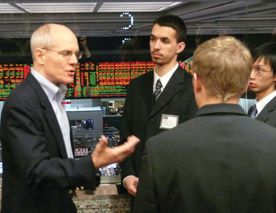
“The Berry Center enables us to offer a high-quality liberal arts program in economics, business, and public policy, and at the same time provide students with experiential learning opportunities that will make them competitive in the workplace,” he said.
It accomplishes this through a variety of opportunities on campus and off. Reading groups, internships, distinguished visitors, and supported classes all line the Berry Center’s own padded resume, and each one holds a unique spot in the menagerie of student opportunities.
The reading groups are among the most unique opportunities the Berry Center provides. For instance, some reading groups are actually led by President Garner himself. The students meet and discuss a preselected book, some of which have included Freakonomics; The White Man’s Burden; One Economics, Many Recipes; and Nudge.
“I love being able to analyze Stephen Levitt’s Freakonomics with President Garner,” said Maggie Rudick ’08 when she was a member of the Berry Center’s very first reading group. “It’s exciting to meet in President Garner’s home and to get to test Katrina’s new pound cake recipes too.”
The reading groups came with other bonuses. For example, students in the Freakonomics group traveled to Chicago, funded by the Berry Center, to meet with the book’s author, Steven D. Levitt. The group who read Nudge was similarly able to meet and discuss the book with University of Chicago economist Richard Thaler, one of the book’s authors.
Relationships like those, forged by the Berry Center, impact the entire campus. Thaler, for example, delivered the Roe Howard Freedom Lecture on May 14, 2009.
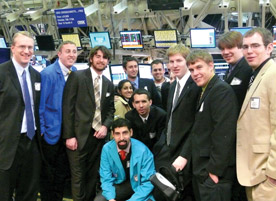
The Berry Center often brings distinguished speakers to the Hilltop. Visitors have included former Congressman and 9/11 Commissioner Tim Roemer, Nobel Laureate in economics Robert Solow, and Kevin Murphy, one of the country’s leading economists. Murphy’s visit, especially, sparked quite a bit of interest.
“It was cool having Murphy here, seeing as how he’s probably the smartest person I’ve been around,” said senior Ben Sebers. No offense intended to Cornell faculty, for sure, since Kevin Murphy is likely the smartest person many people have been around. That’s just the caliber of talent the Berry Center brings in these days.
“I have a huge academic crush on Kevin Murphy. There were jokes that I would faint when I saw him,” said Saunders, her eyes widening as she stressed the word “huge.”
While not every visitor gets fans quite as fervent as Saunders, the personal connections they forge with students do leave them with academic admirers who often find their education enriched by just a few hours with the visitors.
“I remember talking with David Klaus ’67 from the World Bank for like an hour,” said junior Brittany Atchison. “That was awesome.”
Making the experience
While much of the Berry Center’s work is focused on bringing opportunities to campus, a great deal of effort is expended getting students off campus and into experiential programs, primarily in the form of active, engaging internships. Senior art major Matt Smith, for example, was in charge of creative marketing for Amazing Edibles in Chicago during a monthlong internship. While there he created several mailing pieces and took a number of photographs of food preparation for owner Andrea Herrera ’85.
Several internships have placed students directly on a career path. Caitlin Ewing ’08 interned at both Openworld, Inc. in Belize and the Santa Clara University Global Social Benefit Incubator, two globally minded institutions looking to further social and economic change. Ewing is now an independent contractor working for Green Power and Flow— two other globally minded institutions looking to further social and economic change.

“The Berry Center is really what made my college career. It made my experience at Cornell what it was,” said Ewing. “The Berry Center was by far the most important part of my college career.”
Atchison echoed her sentiment, “My internship my freshman year, funded by the Berry Center, was paramount in helping me decide what I wanted to do.”
Additionally, the Berry Center sponsors student research, attendance at academic conferences, distinguished visitors, preparation courses for graduate school and standardized tests, and classes that travel off-campus or otherwise need funding to decrease the burden on students.
This entire package is wrapped together by the efforts of many, but most of the day-to-day work is thanks to Monica Davis Lyons ’02, part coordinator, part teacher, part cheerleader.
“It’s gotten to the point where, anything I need—a job or whatever—I go to Monica,” said Curran.
“A student will say, ‘I want to do this,’ and Monica will say, ‘OK, let’s figure out how we can make this happen,’” said Atchison.
Just as often, Lyons will come to students with ideas. It was Lyons, for example, who first brought up the blueberry farm trip with Saunders and Curran and told them they should apply for it.
“Monica is the ultimate networker. She knows about everyone and everything,” said Saunders. “She doesn’t sit back and wait for [students] to come to her.”
If Lyons is the persona of the Berry Center, Jim McWethy is the driving force behind it.
“A lot of the enthusiasm, vision, and drive to make this happen is Jim McWethy,” said Garner. “He deserves our deep appreciation.”
Blueberries
But what about those blueberries?
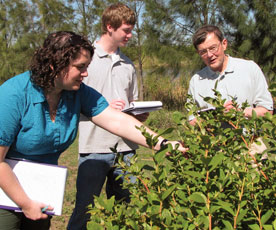
The Berry Center’s connection to a blueberry farm in Uruguay is like many of McWethy’s ventures: seemingly out of place, but so full of insight and purpose that the design appears far more planned than it may be in actuality. Through a series of coincidences, an investment manager named Tom Sleeter introduced McWethy to Pablo Sitjar and Frank Cherry, two of the key players at RenMax, a brokerage firm in Uruguay. Sleeter’s son had done an internship with RenMax, and McWethy picked up that this could be an opportunity for Cornell as well. From there, things developed.
“I thought the whole relationship could be a real good thing for Cornell, and vice versa,” said McWethy. “It’s really one of those things you just lean back and smile about.”
Once invested in RenMax figuratively, McWethy eventually moved to invest literally— in a blueberry farm Sitjar had recently moved to acquire. The Uruguay connection resulted directly in internships with RenMax for Kristin Willard ’08 and senior Vitaly Shmel’kin as well.
The internship, said Willard, was “the best thing I have ever done—I have learned so much about a different culture, about navigating the world, and about myself. I am so glad I made the nerve-wracking decision to take the plunge! Best decision I ever made!”
And it was Willard’s “best decision ever” and the subsequent follow-up internship by Shmel’kin that paved the way for Saunders, Curran, and the Garners to make their way to Uruguay in February 2009.
The purpose of the trip was to produce a case study on entrepreneurship in a developing economy, hopefully leading to insights in education levels, capital, workforces, cash flow, and anything else the small group could qualify, quantify, or observe.
Navigating the case study itself, on the other hand, was aided by Profess … er … President Garner. According to Curran, Garner served as a guide to researching and writing a case study, which neither Curran nor Saunders had ever written, and helped formulate what questions needed to be asked. “He’s so energetic and invested,” added Saunders. “Every morning he’d come down and say ‘so I’ve been thinking about this case study.’”
Garner was equally excited over the opportunity. “I loved it,” he said. “Teaching is my first love, and this sort of collaboration is something that’s special about Cornell.”
Some pretty wonderful things
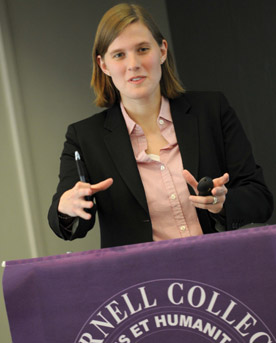
The Berry Center hopes to offer more projects like the Uruguay trip, especially business case studies of entrepreneurial ventures, including some with social objectives. Garner sees this area as a nice fit for a liberal arts college. That also seems to be the mantra for the Berry Center’s future from all of its stakeholders: keep doing what they’re doing, but do more of it.
“The vision of the Berry Center, this has not changed,” said Farooqi. “We want to continue to do what we have done, but we want to increase the activity level and increase the quality.” Sebers, a graduating senior, is one of the last Berry Center devotees who remembers a time before the Berry Center. The class of 2010 is the first fully brought up with the Berry Center. But for those who can remember a time B.B.C. (Before the Berry Center), the changes have been astounding.
“I’ve seen a drastic increase in Berry Center activities in the last two years,” said Sebers.
“The Berry Center offers extraordinary opportunities for Cornell students. It has enhanced the college’s ability to attract students who are well suited to the academic rigor and special programs for study at Cornell,” said Jonathan Stroud, vice president for enrollment and dean of admission. “Initiatives like the Berry Center demonstrate that Cornell is a place of substance and of real opportunity, for both intellectual growth and pre-professional preparation.”
That doesn’t mean Garner, McWethy, Lyons, Farooqi, the Advisory Committee, or others involved in the center are ready to relax. Not even close. They all understand that, through all of the Berry Center’s success thus far, it’s still growing. To continue that growth, The Berry Center, which is currently funded almost entirely by McWethy, has one major need.
“We need to increase the endowment. Absolutely need to do that,” said McWethy. “It’s imperative. My vision is to have it endowed at a minimum of $10 million, preferably more. That would generate enough to do some pretty wonderful things.”
Both he and Garner agree that there are still wonderful things that can be done in the short- and the long-term.
“It takes a while to build a program,” said Garner. “And we still can do a couple things to make it distinctive and valuable, like integrating our strengths as a liberal arts school and our calendar in ways that are unique to us.”
“We have to keep on coming up with new ideas and new innovations,” added McWethy. “I want it to be something that really stands out as exceptional.”

